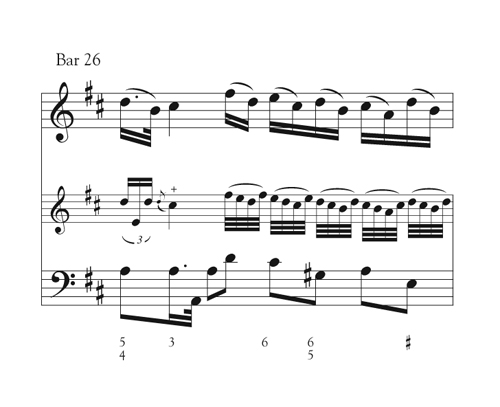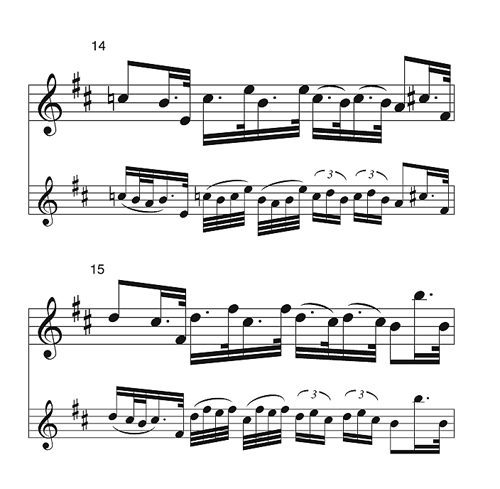Flute pedagogy has grown by leaps and bounds over the past few decades. When I was trained in the late 1960s and early 1970s very few teachers addressed such things as tension in the body or the ergonomics of hand position. Perhaps the biggest change is the increasing importance of teaching Baroque performance practice, which includes ornamentation. While the topic of Baroque ornamentation deserves long and thorough study, the Telemann Methodical Sonatas provide a marvelous place to begin.
Georg Philipp Telemann (1681-1767) was one of the most prolific composers of the late Baroque period. During his lifetime he was more highly regarded than J.S. Bach and was in fact chosen over Bach for a post in Leipzig that he turned down. (Bach, their third choice, later accepted the post.) Telemann was apparently a man of boundless energy, for his output includes over 1000 church cantatas, 600 suites, 46 settings of the Passion, 50 operas, and innumerable chamber music works.
In 1721, after a series of court and church appointments, Telemann became the Kantor of the Hamburg Johanneum, a prestigious post that included directing Hamburg’s five principal churches, various teaching responsibilities, and composing to fill the constant demand for new church and secular compositions. Despite the rigorous demands of this position, he continued to write operas, developed his own publishing house, and in 1728 founded Der getreuer Musikmeister (The Faithful Music Master) a bi-monthly German music periodical, the first of its kind.
During the Baroque period the music world in Europe was small enough that prominent composers were aware of the various styles of the French, Italian, and German composers. Telemann published the first set of his Sonaten Methodische in 1728, the second set in 1732. During the early part of the eighteenth century the influence of the French school, with its written-out embellishments of individual notes, declined (although the practice of playing dotted notes as if they were double-dotted continued). From the autobiography Telemann wrote during this time (1729) we know that, while his earlier works were strongly influenced by the French style, he described himself in the 1720s as composing primarily in the Italian style. The one exception in these sonatas is the Siciliana movement of the B minor sonata, which does include ornaments more in the French style. The Italian/German style generally left ornamentation to the skill of the performer. What a gift, then, to have Telemann’s examples. The ornamentation found in these sonatas (of the first movements only) is less exuberant than the florid ornamentation of Corelli, for example, but it is at times somewhat adventurous, and therefore quite helpful for the performer just beginning to experiment with ornamentation.
The guidance of a good teacher is essential for, as Quantz says, “A beginner is not to be advised, however, to undertake solos in the Italian style prematurely, before he has achieved an understanding of harmony, if he does not wish to retard his own growth…” (Quantz, On Playing the Flute, p. 113). In an ideal world all high school musicians would study music theory, and all flute parts would appear only with the accompaniment, but in the real world these sonatas appear with the figured-bass parts, thus encouraging flutists to view the flute part as a duet with the bass line.
Sonata in D Major, No. 4 (1728)
Any one of these twelve sonatas would be instructive, but I have somewhat arbitrarily chosen the D Major Sonata because it includes some particularly interesting features.
Triplets vs. Dotted Eight and Sixteenth
Note that in the ornamented line, four of the first six bars contain triplets, which brings us to a rhythmic dilemma. If the continuo part has a dotted figure, but the flute player chooses the ornamental triplets, does the 32nd note come with or after the 3rd part of the triplet? Quantz occasionally writes contradicting advice, but on this subject he unequivocally states that the short note should be played after the triplet (p. 68, English edition) because, as he points out, if it coincides with the triplet the meter essentially becomes a compound meter of 68, 128 or, in this case, 2416. So while adding triplets might seem to dull the edgy effect of a dotted rhythm, having the juxtaposition of triplets with dotted notes actually creates its own kind of rhythmic tension, and the practice of double dotting the longer notes gives greater clarity to the resulting complex rhythm. (See example below.)

Neighbor and Passing Tones
Now look at Telemann’s ornamentation of the first measure. On the first beat, rather than playing two Ds, he adds an E upper neighbor tone. Beat two illustrates two principles of ornamentation: going to another pitch in the chord (D to F#) and then filling this interval with a passing tone (E).
Outlining a Chord
Measure three shows a more extensive use of the principle of going to other pitches in the chord, in this case outlining the complete chord of E minor on beats one and two, F# minor on beats three and four. (Notice also the lower neighbors D# on beat two and E on beat four.) Bar five beat three is similar to bar one in that it uses a combination of going to a chord tone, this time via a leap, then filling in with a passing tone; bar six begins with this same ornament. These few bars show three fundamentals of ornamentation: neighbor tones, passing tones, and chord outlines. The correct use of each underscores the importance of knowing the harmony. For example, you cannot use the correct passing tone unless you know the key, and you certainly cannot go to another chord tone unless you know what the chord is. Likewise look at the ornament on beat three of bar five. This ornament is repeated in bar 6 on the first beat with a D#.
Three Steps and a Leap
The four-note combination of three steps and the leap of a 3rd is also used extensively in bar 26, though this time the leap is between the last two notes of the figure instead of the first two. Notice the extensive use of this figure in the second movement (mm. 5, 7, 13, 14, etc.).

Momentum
In addition to making the melodic line more interesting, ornamentation can change the momentum of a passage, which happens in measures six and seven.

Notice the change in measure six; beat three becomes a syncopated rhythm, beat four is now triplets. At the end of bar seven, Telemann begins the use of wide leaps which are continued with the major sevenths in measure eight. The momentum is continued with the addition of thirty-second notes in measures nine through eleven.
Another Variant
A final variation on that stepwise/3rd idea is the figure found in measures 14 and 15, which is the combination of a lower neighbor and the leap of a third. This is a figure one finds frequently (written out) in fast movements of Baroque as well as Classical works.

Putting Ornamentation into Practice
Have students play through and study these and other examples found in the slow movements of the Telemann Methodical Sonatas. Then they can examine pages 140 and 141 of Quantz’s On Playing the Flute for more extravagant ornaments.
Telemann and Handel
Many young flutists’ first encounter with Baroque music is through one of the Handel sonatas. The ornamentation in the Methodical Sonatas can suggest ways to ornament Handel’s sonatas. There are many parallels between the two German composers. They were contemporaries who both were influenced by the Italian style. Since Handel spent several years in Italy, one could make the case for using more florid embellishments in the slow movements of his sonatas; however, using this more elaborate type of ornamentation requires in-depth knowledge of Baroque style, which means studying all of Quantz as well as other Baroque treatises. But be careful, for as Quantz warns, “so many incorrect and awkward ideas appear that it would be better in many cases to play the melody as the composer has set it rather than to spoil it repeatedly with such wretched variations (p. 136).”
It is never too early to start learning the fundamentals of ornamentation, and Telemann’s Methodical Sonatas plus a well-informed teacher will greatly enrich a student’s study of both the Telemann and the Handel Sonatas.






